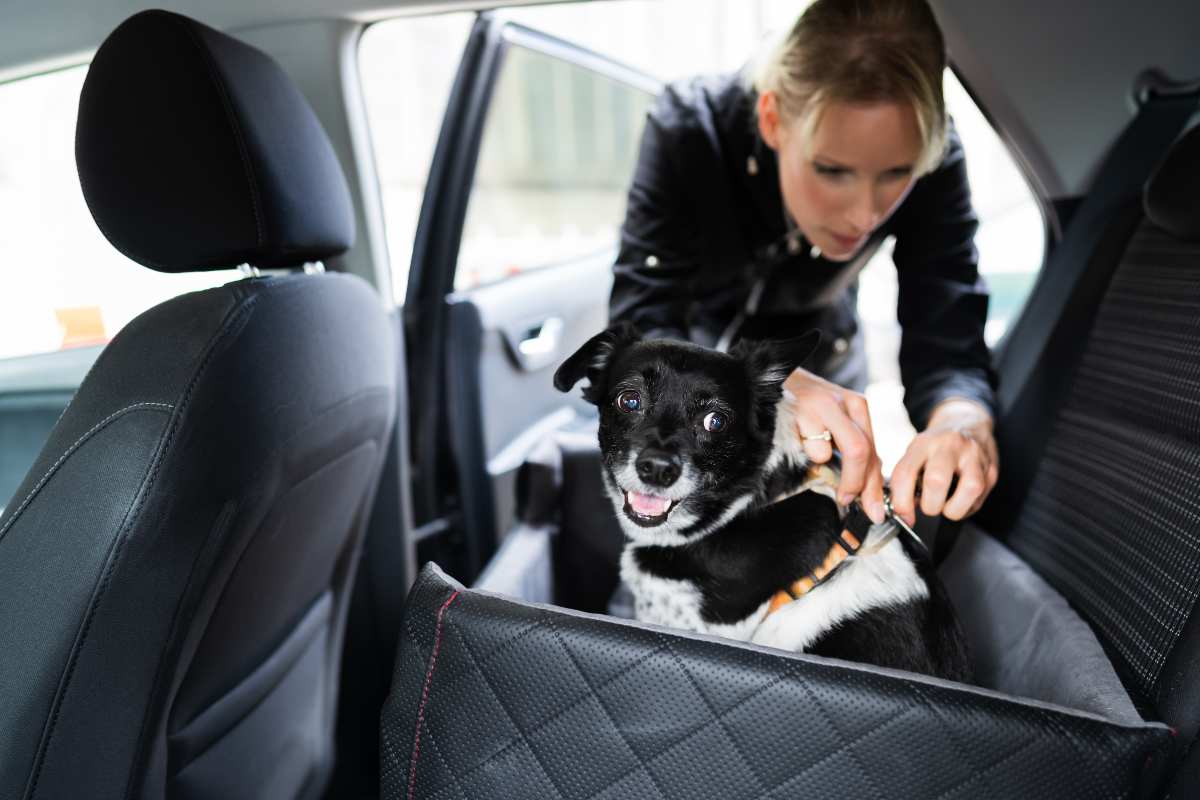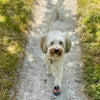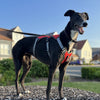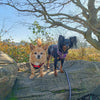How To Keep Your Dog Safe And Content In The Car

Whether it's a short trip to the vet or a road-tripping adventure, ensuring your dog's safety and wellbeing in the car is a top priority. Traveling with your furry friend can be an enjoyable experience, but it requires careful planning and consideration of your dog's comfort and security. In this article, we'll explore the various aspects of keeping your dog safe in the car, from choosing the right restraint to creating a comfortable travel environment.
Choosing the Right Restraint
Crates and Carriers
One of the safest ways to transport your dog is by using a secure crate or carrier. Choose a well-ventilated, crash-tested crate that is appropriate for your dog's size. Ensure that the crate is anchored or secured to prevent it from moving in the event of sudden stops or turns.
Seat Belts and Harnesses
Dog seat belts and harnesses are designed to secure your dog in place during car rides. These restraint systems typically attach to the seat belt or latch system in your car. Look for harnesses that are strong and light and are not too bulky for when your dog lies. Ensure a snug fit to prevent excessive movement.
Travel Barriers
Travel barriers are ideal for larger vehicles like SUVs or hatchbacks. These barriers create a partition between the cargo area and the rest of the car, preventing your dog from roaming freely. Ensure that the barrier is securely installed and that your dog cannot squeeze through any gaps.
Booster Seats
Booster seats are suitable for smaller dogs and are designed to elevate them, allowing them to see out of the window while providing a secure space. Choose a booster seat that can be anchored to the car seat and includes a harness or attachment to keep your dog safely in place.
Preparing Your Dog for Car Travel
Gradual Introductions
Some dogs may feel anxious or uncomfortable in the car. Gradually introduce your dog to the car by allowing them to explore it while stationary. Use positive reinforcement, such as treats and praise, to create positive associations.
Short Trips
Start with short trips to familiarize your dog with the sensation of movement. Gradually increase the duration of the rides as your dog becomes more comfortable. Monitor your dog for signs of stress or motion sickness and adjust accordingly.
Familiar Items
Bring familiar items from home, such as your dog's favorite blanket or toy, to provide comfort and a sense of security during travel. Familiar scents can help reduce stress and make the car a more inviting space.
Regular Breaks
Plan for regular breaks during longer journeys. Allow your dog to stretch their legs, go for a walk, and relieve themselves. Keeping your dog comfortable and relaxed during breaks contributes to an overall positive travel experience.
Safety Measures Inside the Car
Never Leave Your Dog Unattended
Regardless of the weather, never leave your dog unattended in the car. Cars can heat up quickly, even on mild days, posing a severe risk of heatstroke. In cold weather, a car can become too cold for your dog. Always take your dog with you when leaving the vehicle.
Secure Windows
While many dogs enjoy feeling the breeze through an open window, it's crucial to secure windows to prevent your dog from jumping out. Consider using window shades to block direct sunlight and protect your dog from wind.
Avoid Free Roaming
Although it may be tempting to let your dog roam freely inside the car, it poses significant safety risks. Sudden stops or turns can lead to injury, and an unrestrained dog is more likely to be injured in the event of a collision.
Protective Coverings
Use seat covers or protective coverings to shield your car's interior from dirt, hair, and potential accidents. These covers also provide your dog with a designated space and protect them from slipping or sliding during the journey.
Recognising and Addressing Motion Sickness
Gradual Exposure
If your dog experiences motion sickness, gradually expose them to car rides in short increments. This allows them to acclimate to the sensation of movement without triggering nausea.
Empty Stomach
Avoid feeding your dog a large meal before a car trip. An empty stomach can help reduce the likelihood of motion sickness. However, make sure to provide small sips of water to prevent dehydration.
Fresh Air
Ensure proper ventilation inside the car. Crack a window or use the air conditioning to provide fresh air, which can help alleviate symptoms of motion sickness.
Consult Your Veterinarian
If motion sickness persists, consult your veterinarian. They may recommend specific medications or strategies to address your dog's individual needs.
Addressing Anxiety and Stress
Familiarise with the Car
Create positive associations by associating the car with enjoyable activities. Feed your dog treats inside the stationary car, play with them, and gradually increase the time spent in the vehicle.
Comfort Items
Bring comfort items from home, such as a favorite toy or blanket, to provide a sense of familiarity and security. Consider using calming aids like pheromone sprays or wraps to reduce anxiety.
Training and Desensitisation
Implement training techniques to desensitize your dog to car travel. Gradually expose them to the car in a positive and controlled manner, rewarding calm behavior with treats and praise.
Safe Spaces
Allow your dog to have a designated safe space within the car, whether it's a comfortable bed or a cozy corner. This provides a retreat where your dog can feel secure during the journey.
Tips for a Safe and Enjoyable Car Trip with Your Dog
Pre-Trip Health Check
Ensure your dog is in good health before embarking on a long journey. Schedule a pre-trip visit to the veterinarian to address any potential health concerns and confirm that your dog is fit for travel.
Identification Tags
Ensure your dog wears a secure collar with identification tags containing current contact information. In the event of an unforeseen circumstance, this ensures a swift reunion if your dog becomes lost.
Microchipping
Consider microchipping your dog for an added layer of identification. Keep the microchip information updated with your current contact details.
Emergency Kit
Pack a travel emergency kit for your dog, including essentials such as water, food, medications, first aid supplies, and a copy of their medical records. Be prepared for unexpected stops or delays.
Secure Trash and Hazardous Items
Dogs may be curious, and the car can be filled with potential hazards. Secure trash, stow away hazardous materials, and keep potentially harmful items out of your dog's reach.
Weather Considerations
Consider the weather conditions when planning a car trip with your dog. In hot weather, avoid midday travel, and always have provisions to keep your dog cool. In cold weather, provide blankets or a heated bed to ensure warmth.
Frequent Stops
Plan for frequent stops to allow your dog to stretch, walk, and relieve themselves. These breaks contribute to their overall well-being and comfort during the journey.
Carry Water
Always carry an ample supply of fresh water for your dog. Hydration is crucial, especially during extended car rides or in warm weather.
Stay Calm and Patient
Dogs can pick up on their owner's emotions. Stay calm and patient, offering reassurance and positive reinforcement. A calm and relaxed atmosphere contributes to a positive travel experience for your dog.
Train and Reinforce
Consistent training and reinforcement contribute to a dog's overall behavior during car trips. By reinforcing positive behaviors and addressing any challenges proactively, you create a foundation for enjoyable future travels.
Ensuring your dog's safety in the car requires a combination of thoughtful preparation, appropriate restraints, and a keen understanding of your dog's individual needs. By choosing the right restraint system, acclimating your dog to the car gradually, and addressing any potential issues such as motion sickness or anxiety, you create an environment where your furry companion can travel safely and comfortably.
Remember, every dog is unique, and tailoring your approach to their specific needs is key. Whether it's a short drive or an extended road trip, with the right precautions and a dash of patience, you and your canine co-pilot can embark on countless adventures together, ensuring safe and joyous travels for years to come. Happy trails!
Please note: Highway Code does provide guidance on traveling with pets. Rule 57 specifically covers animals in vehicles and advises:
"When in a vehicle make sure dogs or other animals are suitably restrained so they cannot distract you while you are driving or injure you, or themselves, if you stop quickly. A seat belt harness, pet carrier, dog cage or dog guard are ways of restraining animals in cars."
Wiggles and Wags offers a range of lightweight, strong harnesses for the car and also seat belt clips to restrain your dog comfortably and safely.
-
Posted in
dog safety, dogs in cars





